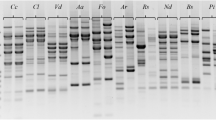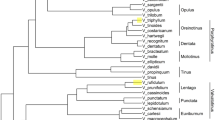Abstract
Twelve simple sequence repeat (SSRs) loci were used to evaluate genetic diversity of 109 isolates of Macrophomina phaseolina collected from different geographical regions and host species throughout the United States (US). Genetic diversity was assessed using Nei’s minimum genetic distance, and the usefulness of each locus was determined by calculating the polymorphism information content (PIC). A total of 98 alleles were detected and of these 31 were unique to individual genotypes. Eight of twelve loci were highly informative with PIC values greater than 0.50. The majority of pairwise comparisons of genetic distance were greater than 0.60 indicating moderate to high genetic diversity. Dendrograms based on the genetic dissimilarities were created for the 109 isolates of which 79 were from soybean. Some clustering by host and geography was noted, but, the dendrograms generally grouped isolates independent of host or geography. Additionally, sequencing of the internal transcribed spacer region (ITS) for 10 isolates revealed that all of these isolates were 99% similar. Three SSR loci from M. phaseolina were cross amplified in other genera in the Botryosphaeriaceae. This was the first study of genotyping and assessing genetic diversity of M. phaseolina isolates collected from a widespread host and geographic range across the US with SSRs. With an additional 34 loci publically available for M. phaseolina, the results indicate that previously developed SSRs from one species can be used in future population, ecological, and genetic studies of M. phaseolina and other genera within the Botryosphaeriaceae.


Similar content being viewed by others
References
Dhingra OD, Sinclair JB. Biology and pathogenicity of Macrophomina phaseolina. Viscosa, Brazil: Universidade Federal de Viscosa; 1978.
Mihail JD. Macrophomina. In: Singleton LS, Mihail JD, Rush CM, editors. Methods for research on soilborne phytopathogenic fungi. St. Paul, MN: American Phytopathological Society Press; 1992. p. 134–6.
Srivastava AK, Singh T, Jana TK, Arora DK. Microbial colonization of Macrophomina phaseolina and suppression of charcoal rot of chickpea. In: Sinha A, editor. Microbes and plants. New Dehli: Vedams eBooks; 2001. p. 269–319.
Kunwar IK, Singh T, Machado CC, Sinclair JB. Histopathology of soybean seed and seedling infection by Macrophomina phaseolina. Phytopathology. 1986;76:532–5.
Mihail JD, Taylor SJ. Interpreting variability among isolates for Macrophomina phaseolina in pathogenicity, pcynidium production and chlorate utilization. Can J Bot. 1995;10:1596–603.
Srivastava AK, Singh RB. Effects of organic amendment on interaction of Macrophomina phaseolina and Meloidogyne incognita on fresh bean (Phaseolina vulgaris). New Agri. 1990;1:99–100.
Wrather JA, Anderson TR, Arsyad DM, Tan Y, Ploper LD, Porta-Puglia A, et al. Soybean disease loss estimates for the top 10 soybean producing counties in 1998. Can J Plant Pathol. 2001;23:115–21.
Su G, Suh SO, Schneider RW, Russin JS. Host specialization in the charcoal rot fungus, Macrophomina phaseolina. Phytopathology. 2001;91:120–6.
Crous PW, Slippers B, Wingfield MJ, Rheeder J, Marasas WFO, Philips AJL, et al. Phylogenetic lineages in the Botryosphaeriaceae. Stud Mycol. 2006;55:235–53.
Mayek-Pérez N, López CC, González-Chavira M, García-Espinosa R, Acosta-Gallegos JA, Martínez-De la Vega O, et al. Variability of Mexican isolates of Macrophomina phaseolina based on pathogenesis and AFLP genotype. Mol Plant Pathol. 2001;59:257–63.
Vandemark G, Martínez O, Pecina V, Alvarado MJ. Assessment of genetic relationships among isolates of Macrophomina phaseolina using a simplified AFLP technique and two different methods of analysis. Mycologia. 2000;92:656–64.
Jana TK, Sharma TR, Prasad RD, Arora DK. Molecular characterization of Macrophomina phaseolina and Fusarium species by using single primer RAPD technique. Microbiol Res. 2003;158:249–57.
Jana T, Sharma TR, Singh NK. SSR-based detection of genetic variability in the charcoal root rot pathogen Macrophomina phaseolina. Mycol Res. 2005;109:81–6.
Purkayastha BK, Arora P, Bisyer I, Dilbaghi N, Chaudhury A. Molecular genotyping of Macrophomina phaseolina isolates: Comparison of microsatellite primed PCR and repetitive element sequence-based PCR. J Phytopathol. 2008;156:372–81.
Reyes-Franco MC, Hernández-Delgado S, Beas-Fernández R, Medina-Fernández M, Simpson J, Mayek-Pérez N. Pathogenic and genetic variability within Macrophomina phaseolina from Mexico and other countries. J Phytopathol. 2006;154:447–53.
Baird RE, Wadl PA, Wang X, Johnson DH, Rinehart TA, Abbas HK, et al. Microsatellites from the charcoal rot fungus (Macrophomina phaseolina). Mol Ecol Resour. 2009;9:946–8.
Groppe K, Sanders I, Wiemken A, Boller T. A microsatellite marker for studying the ecology and diversity of fungal endophytes (Epichloë spp.) in grasses. Appl Environ Microb. 1995;61:3943–9.
Baird RE, Trigiano RN, Windham G, Williams P, Kelly R, Abbas HK, et al. Comparison of aflatoxigenic and nonaflatoxigenic isolates of Aspergillus flavus using DNA amplification fingerprinting techniques. Mycopathologia. 2006;161:93–9.
White TJ, Brun T, Lee S, Taylor J. Amplification and direct sequencing of fungal ribosomal RNA genes for phylogenetics. In: Innis MA, Gelfand DH, Sninsky JJ, White TJ, editors. PCR Protocols. A guide to methods and applications. San Diego, USA: Academic Press; 1990. p. 315–20.
Larkin MA, Blackshields G, Brown NP, Chenna R, McGettigan PA, McWilliam H, et al. Clustal W and Clustal X version 2.0. Bioinformatics. 2007;23:2947–8.
Amos W, Hoffman JI, Frodsham A, Zhang L, Best S, Hill VS. Automated binning of microsatellite alleles: problems and solutions. Mol Ecol Notes. 2007;7:10–4.
Anderson JA, Churcill GA, Autrique JE, Tanksley SD, Sorrels ME. Optimizing parental selection for genetic linkage maps. Genome. 1992;36:181–6.
Langella O. Populations: population genetic software (individuals or populations distances, phylogentic trees). 2002. www.bioinformatics.org/project/?group_id=84.
Nei M. Genetic distance between populations. Am Nat. 1973;106:283–92.
Rohlf FJ. NTSYS-pc numerical taxonomy and multivariate analysis system, version 1.70. Setauket, NY: Exeter Software; 1992.
Botstein D, White RL, Skolnick M, Davis RW. Construction of a genetic linkage map in man using restriction fragment length polymorphisms. Am J Hum Genet. 1980;32:314–31.
Karaoglu H, Lee CMY, Meyer W. Survey of simple sequence repeats in completed fungal genomes. Mol Biol Evol. 2005;22:639–49.
Rossetto M. Sourcing of SSR markers from related plant species. In: Henry RJ, editor. Plant genotyping—the DNA fingerprinting of plants. New York, NY: CABI Publishing; 2001. p. 211–24.
Peakall R, Gilmore S, Keys W, Morgante M, Rafalski A. Cross species amplification of soybean (Glycine max) simple sequence repeats (SSRs) within the genus and other legume genera: implications for the transferability of SSRs in plants. Mol Biol Evol. 1998;15:1275–87.
Dutech C, Enjalbert J, Fournier E, Delmotte F, Barrès B, Carlier J, et al. Challenges of microsatellite isolation in fungi. Fungal Genet Biol. 2007;44:933–49.
Cristancho M, Escobar C. Transferability of SSR markers from related Uredinales species to the coffee rust Hemileia vastatrix. Genet Mol Res. 2008;7:1186–92.
Das IK, Fakrudin B, Arora DK. RAPD cluster analysis and chlorate sensitivity of some Indian isolates of Macrophomina phaseolina from sorghum and their relationships with pathogenicity. Mycol Res. 2008;163:215–24.
Rajkumar FB, Kuruvinashetti MS. Genetic variability of sorghum charcoal rot pathogen (Macrophomina phaseolina) assessed by random DNA markers. Plant Pathology J. 2007;23:45–50.
Acknowledgments
Approved for publication as Journal Article No. J-11724 of the Mississippi Agricultural and Forestry Experiment Station, Mississippi State University. This work was supported by USDA Agreement no. 58-6404-7-213. Mention of trade names or commercial products in this article is solely for the purpose of providing specific information and does not imply recommendation or endorsement by the University of Tennessee or the USDA.
Author information
Authors and Affiliations
Corresponding author
Additional information
Equal work was done by Richard E. Baird and Phillip A. Wadl.
Rights and permissions
About this article
Cite this article
Baird, R.E., Wadl, P.A., Allen, T. et al. Variability of United States Isolates of Macrophomina phaseolina Based on Simple Sequence Repeats and Cross Genus Transferability to Related Genera Within Botryosphaeriaceae. Mycopathologia 170, 169–180 (2010). https://doi.org/10.1007/s11046-010-9308-3
Received:
Accepted:
Published:
Issue Date:
DOI: https://doi.org/10.1007/s11046-010-9308-3




